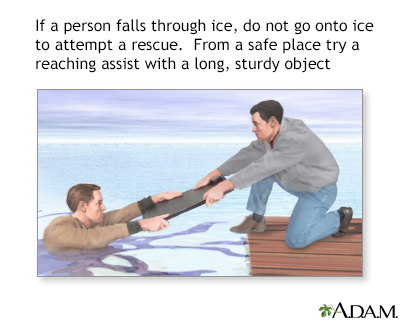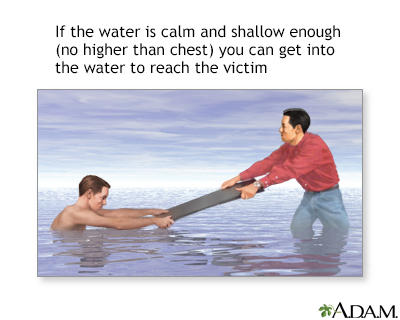Non-fatal drowning
Drowning - non-fatal; Near drowning
Non-fatal drowning means a person developed trouble breathing from being underwater or having their head underwater, and survived.
If a person has been rescued from a non-fatal drowning situation, quick first aid and medical attention are very important.
Images





I Would Like to Learn About:
Considerations
- Thousands of people drown in the United States each year. Most drownings occur within a short distance of safety. Immediate action and first aid can prevent death.
- A person who is drowning usually can't shout for help. Be alert for signs of drowning.
- Most drownings in children younger than 1 year occur in the bathtub.
- It may be possible to revive a drowning person, even after a long period under water, especially if the person is young and was in very cold water.
- Suspect an accident if you see someone in the water fully clothed. Watch for uneven swimming motions, which is a sign that the swimmer is getting tired. Often, the body sinks, and only the head shows above the water.
Causes
- Attempted suicide
- Attempting to swim too far
- Behavioral/developmental disorders
- Blows to the head or seizures while in the water
- Drinking alcohol or using other drugs while boating or swimming
- Heart attack or other heart issues while swimming or bathing
- Failure to use life jackets (personal flotation devices)
- Falling through thin ice
- Inability to swim or panicking while swimming
- Leaving small children unattended around bathtubs or pools
- Risk-taking behaviors
- Swimming in water that is too deep, rough, or turbulent
Symptoms
Symptoms can vary, but may include:
- Swollen belly (abdominal distention)
- Bluish skin of the face, especially around the lips
- Chest pain
- Cold skin and pale appearance
- Confusion
- Cough with pink, frothy sputum
- Irritability
- Lethargy
- No breathing
- Restlessness
- Shallow or gasping respirations
- Unconsciousness (lack of responsiveness)
- Vomiting
First Aid
When someone is drowning:
- Do not place yourself in danger.
- Do not get into the water or go out onto ice unless you are absolutely sure it is safe.
- Extend a long pole or tree branch to the person or use a throw rope attached to a buoyant object, such as a life ring or life jacket. Toss it to the person, then pull them to shore.
- If you are trained in rescuing people, do so right away only if you are sure it will not cause you harm.
- Keep in mind that people who have fallen through ice may not be able to grasp objects within their reach or hold on while being pulled to safety.
If the person's breathing has stopped, begin rescue breathing as soon as you can. This often means starting the rescue breathing process as soon as the rescuer can get to a flotation device such as a boat, raft, or surf board, or reaches water where it is shallow enough to stand.
Continue to breathe for the person every few seconds while moving them to dry land. Once on land, give CPR as needed. A person needs CPR if they are unconscious and you can't feel a pulse.
Always use caution when moving a person who is drowning. Neck injuries are uncommon in people who survive drowning unless they have been struck in the head or show other signs of injury, such as bleeding and cuts. However, neck and spine injuries may occur when a person dives into water that is too shallow. Because of this, the American Heart Association guidelines recommend against strictly immobilizing the spine unless there are obvious head injuries. Doing so can make it more difficult to perform rescue breathing on the victim. However, you should try to keep the person's head and neck stable and aligned with the body as much as possible during the rescue from the water and CPR. You can tape the head to a backboard or stretcher, or secure the neck by placing rolled towels or other objects around it.
Follow these additional steps:
- Give first aid for any other serious injuries.
- Keep the person calm and still. Seek medical help right away.
- Remove any cold, wet clothes from the person and cover with something warm, if possible. This will help prevent hypothermia.
- The person may cough and have difficulty breathing once breathing restarts. Reassure the person until you get medical help.
Do Not
Important safety tips:
- Do not attempt a swimming rescue yourself unless you are trained in water rescue, and can do so without endangering yourself.
- Do not go into rough or turbulent water that may endanger you.
- Do not go on the ice to rescue someone.
- If you can reach the person with your arm or an extended object, do so.
The Heimlich maneuver is not part of the routine rescue of non-fatal drownings. Do not perform the Heimlich maneuver unless repeated attempts to position the airway and rescue breathing have failed, and you think the person's airway is blocked. Performing the Heimlich maneuver increases the chances that an unconscious person will vomit and then choke on the vomit.
When to Contact a Medical Professional
Call 911 or the local emergency number if you can't rescue the drowning person without putting yourself in danger. If you are trained and able to rescue the person, do so, but always call for medical help as soon as possible.
All people who have experienced a non-fatal drowning should be checked by a health care provider. Even though the person may quickly seem OK at the scene, lung complications are common. Fluid and body chemical (electrolyte) imbalances may develop. Other traumatic injuries may be present, and irregular heart rhythms can occur.
All people who have experienced a non-fatal drowning and require any form of resuscitation, including rescue breathing alone, should be transported to the hospital for evaluation. This should be done even if the person appears alert with good breathing and a strong pulse.
Prevention
Some tips to help prevent non-fatal drowning are:
- Do not drink alcohol or use other drugs when swimming or boating. This includes certain prescription medicines.
- Do not leave any standing water in basins, buckets, ice chests, kiddie pools, or bathtubs, or in other areas where a young child can enter the water. Drowning can occur in any container of water.
- Secure toilet seat lids with a child safety device.
- Build a fence around all pools and spas. Secure all the doors leading to the outside, and install pool and door alarms.
- Check the pool right away, if your child is missing.
- Never allow children to swim alone or unsupervised regardless of their ability to swim.
- Never leave children alone for any period of time or let them leave your line of sight around any pool or body of water. Drownings have occurred when parents left "for just a minute" to answer the phone or door.
- Observe water safety rules.
- Take a water safety course.
References
Hargarten SW, Frazer T. Injuries and injury prevention. In: Keystone JS, Kozarsky PE, Connor BA, Nothdurft HD, Mendelson M, Leder, K, eds. Travel Medicine. 4th ed. Philadelphia, PA: Elsevier; 2019:chap 50.
Merchant RM, Topjian AA, Panchal AR, et al. Part 1: Executive Summary: 2020 American Heart Association guidelines for cardiopulmonary resuscitation and emergency cardiovascular care. Circulation. 2020;142(16_suppl_2):S337-S357. PMID: 33081530 pubmed.ncbi.nlm.nih.gov/33081530/.
Richards DB. Drowning. In: Walls RM, ed. Rosen's Emergency Medicine: Concepts and Clinical Practice. 10th ed. Philadelphia, PA: Elsevier; 2023:chap 133.
Thomas AA, Caglar D. Drowning and submersion injury. In: Kliegman RM, St. Geme JW, Blum NJ, Shah SS, Tasker RC, Wilson KM, eds. Nelson Textbook of Pediatrics. 21st ed. Philadelphia, PA: Elsevier; 2020:chap 91.
BACK TO TOPReview Date: 11/2/2023
Reviewed By: Jesse Borke, MD, CPE, FAAEM, FACEP, Attending Physician at Kaiser Permanente, Orange County, CA. Also reviewed by David C. Dugdale, MD, Medical Director, Brenda Conaway, Editorial Director, and the A.D.A.M. Editorial team.

Health Content Provider
06/01/2025
|
A.D.A.M., Inc. is accredited by URAC, for Health Content Provider (www.urac.org). URAC's accreditation program is an independent audit to verify that A.D.A.M. follows rigorous standards of quality and accountability. A.D.A.M. is among the first to achieve this important distinction for online health information and services. Learn more about A.D.A.M.'s editorial policy, editorial process and privacy policy. A.D.A.M. is also a founding member of Hi-Ethics. This site complied with the HONcode standard for trustworthy health information from 1995 to 2022, after which HON (Health On the Net, a not-for-profit organization that promoted transparent and reliable health information online) was discontinued. |
The information provided herein should not be used during any medical emergency or for the diagnosis or treatment of any medical condition. A licensed medical professional should be consulted for diagnosis and treatment of any and all medical conditions. Links to other sites are provided for information only -- they do not constitute endorsements of those other sites. © 1997- 2025 A.D.A.M., a business unit of Ebix, Inc. Any duplication or distribution of the information contained herein is strictly prohibited.
